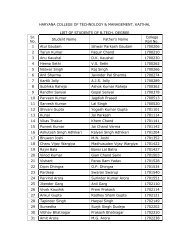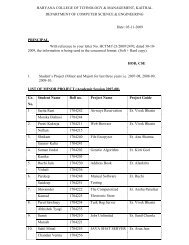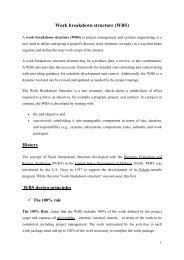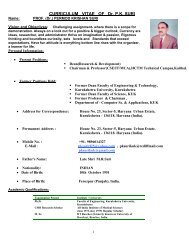Create successful ePaper yourself
Turn your PDF publications into a flip-book with our unique Google optimized e-Paper software.
LECTURE NOTES OF ADVANCED DATA STRUCTURE (MT-CSE 110)<br />
Introduction:‐<br />
A graph traversal means visiting all the nodes of the graph . Graph<br />
traversal may be needed in many of the application areas.<br />
Given the root node of a binary tree, one of the most common<br />
things one wishes to do is to traverse the tree and visit the nodes in some<br />
order. In the case of trees, we have three ways to traverse it i.e.<br />
PREORDER, INORDER and POSTORDER. An analogous problem arises in<br />
the case of Graphs.<br />
Given an undirected graph G= (V, E) and a vertex v in V (G) we are<br />
inserted in visiting all vertices in G that are reachable from v (i.e., all<br />
vertices connected to v). We shall look at two ways of doing this:‐<br />
<strong>1.</strong> Depth First Traversal(Depth First Search)<br />
2. Breadth First Traversal(Breadth First Search)<br />
Both techniques produce a systematic traverse and when properly applied are<br />
useful for checking some basic properties of graphs. Both traverse the graph<br />
along the edges of a forest (spanning tree if the graph is connected).<br />
DFS (Depth first search)<br />
Depth‐first search (DFS) is an algorithm for traversing or searching a tree, tree<br />
structure, or graph. One starts at the root (selecting some node as the root in<br />
the graph case) and explores as far as possible along each branch<br />
before backtracking<br />
DFS is an uninformed search that progresses by expanding the first<br />
child node of the search tree that appears and thus going deeper and<br />
deeper until a goal node is found, or until it hits a node that has no<br />
children. Then the search backtracks, returning to the most recent node it<br />
hasn't finished exploring. In a non‐recursive implementation, all freshly<br />
expanded nodes are added to a stack for exploration.<br />
The time and space analysis of DFS differs according to its<br />
application area. In theoretical computer science, DFS is typically used to<br />
traverse an entire graph, and takes time O(|V| + |E|), linear in the size of<br />
the graph. In these applications it also uses space O(|V| + |E|) in the<br />
Prepared By :<br />
Er. Harvinder Singh<br />
Assist Prof., CSE, H.C.T.M (Kaithal) Page ‐ 83 ‐







